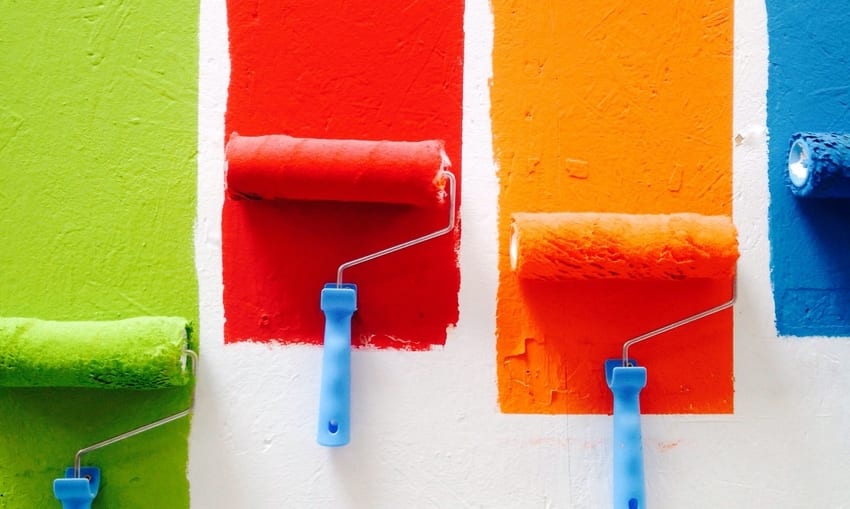Last Updated on January 1, 2024
Dehumidifiers are useful appliances for reducing humidity to comfortable levels in your living space. Due to cooling cycle, naturally, they collect some water from the environment by condensation, which needs to be evacuated. But what if dehumidifier keeps filling rapidly and it is a source of continuous distress?
Generally, there are several ways to drain water from your dehumidifier, i.e., bucket, drain port and condensate pump. However, by default, water will collect in the bucket, if none of the other methods of drainage are used. Drain in bucket is primary and sometimes only applicable way when accessibility to drain target is not easy, for example, basement, attics etc.
There is a lot of detail and technicalities involved for true identification of the fault. But worry not, I have got you covered. In this article, I cover diagnosis of 9 faults, that could be causing repeated and rapid fill-ups, as well as their solutions. Here are 9 reasons why your dehumidifier keeps filling with water quickly:
1. High Humidity in Your Region
Most of the dehumidifiers used now-a-days are based on vapor compression cycle. This means they extract water from the surroundings of your living space by condensation.
Air is pushed through your dehumidifier’s cooling coils by the application of a fan. These coils are maintained at a temperature below dew point. When humid air comes in contact with cooling coils water condenses and collects in bucket.
The most effecting factor causing your dehumidifier to fill up quickly is average relative humidity in the region where you live.
The greater the relative humidity in environment of your region, the greater will be the quantity of water that your dehumidifier will extract in a definite interval of operation. This means you will have to empty your bucket more often.
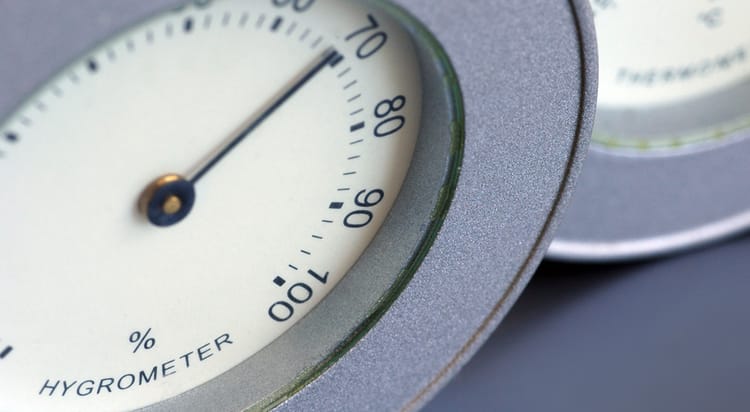
For example, recommended range of relative humidity is from 30-50%. However, In Texas and Louisiana, on average, it is about 75 percent. This is very high comparatively. That is why they are among the top humid cities in America.
If you happen to live in one of these regions of US or any other comparable regions in the world, you will have to empty dehumidifier pretty many times compared to normal.
In cities with low humidity, like Nevada or Arizona, having comparatively very low average relative humidity (below 40 percent), frequency of drainage will be very low.
Note: Some regions have overall relative humidity higher than others. Relative humidity also changes from day to night and from season to season.
Generally, depending upon humidity in your region, you will have to empty your dehumidifier a couple of times a week to several times a day.
There is no fixed number of times to empty your dehumidifier, more than which you identify that it is faulty. If humidity is fairly high, I would start worrying only when I have to empty my dehumidifier more than twice a day.
Solutions
If you have to empty your dehumidifier several times a day, it can interrupt your daily tasks. In case you do identify that this is due to relative humidity, you can use other draining options. You can either use a drain hose to extract water or a condensate pump.
Getting rid of water automatically via drain hose requires gravity. Which means that the location where you need to drain water needs to be lower than the drain port. Thereby, consider relative height of your draining location before using this option. However, by using condensate pump you will not have this restriction.
A condensate pump will work in all situations, regardless of height limitations. I saved you the trouble of finding it and picked one for you. Click here to see specifications.
2. Choked Air Filters Due to Dirt
Air moving through your dehumidifier is filtered before it comes in contact with coils. Some models may have more than one filters installed in them.
With time, filter will be blocked by dirt and it will need cleaning. Not cleaning in this state will have two major demerits:
- Airflow will be reduced. This may cause your compressor to work harder and overheat.
- Air will move through the sides and bypass the filter. This will result in clogging of dehumidifier coils.
- Restricted airflow will cause frost buildup.
The third side effect of dirty filter i.e., frosting or icing of evaporator coils, may be the reason for your dehumidifier bucket continuously filling up.
When flow rate becomes inadequately low, quantity of air coming in contact with cooling coils will be reduced. As a result, temperature of cooling coils will go very low to cause ice buildup. This ice will melt with time and cause your dehumidifier bucket to fill up.
After sufficient ice buildup your dehumidifier will most probably go into defrosting mode. In this mode, it will cause the compressor to shut off while keeping the fan ON.
As a result, water will drip continuously in the drain pan causing it to fill very fast.
Due to frosting, bucket will keep filling up even if dehumidifier is turned off. This is because of melting of ice with time. Also, in case bucket is full, water will keep dripping causing it to spill on the floor.
Solutions
Make a routine for cleaning your filters. How often you clean them is variable and depends upon duration and conditions of operation.
Manufacturer recommend cleaning filters after different durations of time. Some recommend it every week, others every three weeks and some after certain hours have passed.
Some manufacturers (like Frigidaire) also have what is called filter reset indicator. Sometimes also referred to as clean filter or check filter by others. They all mean the same. It turns on after specific hours of operation have passed.
At this point, your dehumidifier will usually not run until you take filter out and clean it.
Filters in dehumidifiers are almost always reusable. No need to change them, except when damaged. Use lukewarm water to wash the air filter gently. Allow it to dry properly before inserting it back.
3. Newly Bought Dehumidifier
It is possible but rare that you get a dehumidifier that is malfunctioning or has an internal faulty from the manufacturer. Usually, if does have a fault, it is due to other reasons like damage in handling, transportation etc.
For a competitive industry like dehumidifier, companies are very careful regarding quality of their products. That is why your dehumidifier goes through several preliminary checks before reaching you and they give you great return policy.
One of another interesting reasons for a newly bought dehumidifier to repeatedly fill up with water is the fact that you just got it.
But why is that? Actually, a dehumidifier in a new place, i.e. never been dehumidified before, or at least for a long time, extracts enormous humidity from various other sources despite air.
A good amount of moisture also needs to be extracted from different components of the room like floor, ceiling, furniture, walls etc.
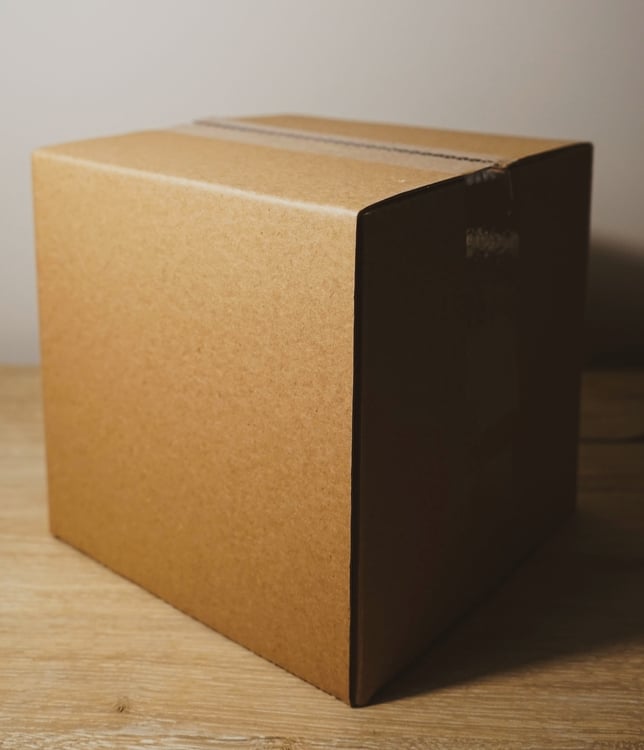
Solutions
It is not possible to exactly identify water content in different objects of a room. But if air is your room has been humid for some time, it is very likely that other components have considerable amount of water in them.
Sometimes, it is very prominent if you have water damage or mold growing.
Easy Way to Identify High Moisture Content in Your Room
Let me tell you an easy way to identify that either quick filling of your dehumidifier is due to high moisture content of accessories in the room or it is faulty.
As I talked about before, there is a flexible return policy and manufacturer gives you ample time to return the appliance if it is not working.
Run your new dehumidifier in the most humid room of your home possible that has not been dehumidified for a while. Allow it to operate for a couple of days at maximum performance and most time of day.
If you notice that slowly condensate collecting is reducing, this is an indication that objects of the room had high moisture content in them. It is slowly being extracted by your dehumidifier.
If not, there might be other problems that may or may not be repairable. Either way you should return the unit.
4. Blocked Dehumidifier Coils
There are two types of coils present in a dehumidifier: Evaporator Coils and Condenser Coils.
Air that is pushed by dehumidifier fan passes through both of these coils.
For proper and consistent dehumidification, air needs to come in contact with the evaporator coils at a sufficient flowrate.
If dehumidifier coils are clogged, air passage will be blocked partially. This will cause a drop in airflow rate to the extent resulting in frosting or icing of coils. Ice will melt and keep dripping continuously filling dehumidifier bucket.
Dust and dirt keep accumulating in coils with time and their cleaning is required from time to time.
Both types of coils are mandatory for functioning of dehumidifier refrigeration cycle. However, condensation specifically occurs at evaporator coils and so does the frosting.
Solutions
Identification of clogged dehumidifier coils as the reason of bucket filling quickly is easy:
Icing of cooling coils.
Note: There might be other reasons for freezing of coils too, like dirty filter or low refrigerant. I recommend firstly checking filters then looking for blockage in dehumidifier coils.
After diagnosis and knowing dehumidifier coils are the culprit, clean them. Use a soft brush for that purpose. Clean them in the direction of tubes. These coils are very sensitive and delicate. If damaged, you might have to replace the coils entirely.
Accessibility of dehumidifier coils depend upon the manufacturer and model of your unit. Some give easy access to them, while others don’t. If they are not easily accessible and you don’t have enough experience, you can vacuum through the holes above coils.
Best is to expose the dehumidifier coils. Clean debris and dirt carefully, with a suitable brush, in gentle upward and downward motion. Then you could either use a solution like warm water and detergent or dish washer liquid to clean your dehumidifier coils.
However, there is a perfect product for this purpose. It is specifically built for cleaning coils and able to easily liquefy dirt, oil and grease. It consists of corrosion inhibitors (saves from corrosion unlike water) and has a pleasant smell after application. Give a look at its specification by clicking here.
5. Slow or Inoperative Dehumidifier Fan
As I discussed earlier, reduced flowrate of air through dehumidifier coils causes them to achieve temperature low enough to cause frosting.
One of less likely but possible reasons for this could be a malfunctioning dehumidifier fan. Fan is responsible for consistent flowrate of air through cooling coils.
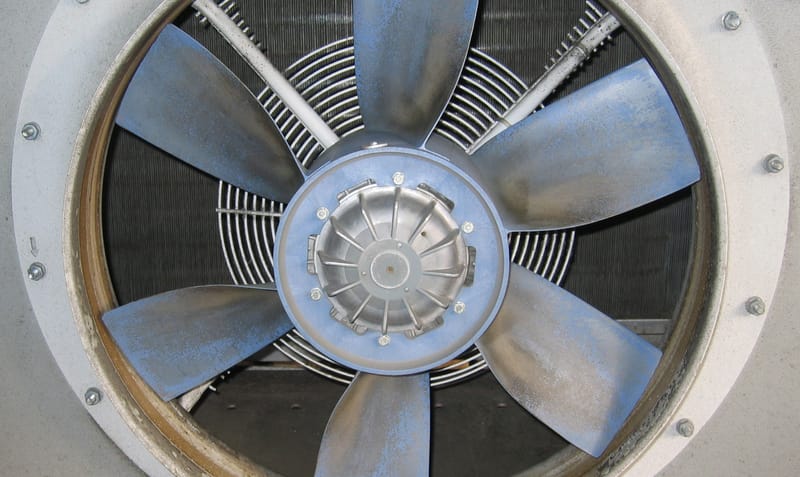
When dehumidifier fan or blower is working at a reduced speed than recommended, or not working at all, this will reduce flowrate and develop ice. This ice will continuously melt and drain in your dehumidifier bucket. Even if it is full or dehumidifier is turned off.
Solutions
There can be a number of reasons why your dehumidifier fan may not be delivering recommended flowrate to prevent frosting. Let me discuss major ones for you:
- Blower motor is not working right. Motor needs to be checked for shortages and continuation. If you discover a complicated internal fault, I personally advice you to just buy a new one. It will save you a lot of trouble.
- Fan Blades are Damaged. Not enough air is being pulled by the blades. If you see a broken fragment or any other damage to blower blades, you will have to get it replaced.
- Defective Electronic Components Required for Running Fan. One of the reasons why your fan is running at a slow speed, or not running at all, could be electronic components like switch, capacitor, relay, control board etc.
Visually, if you can identify a problem with the dehumidifier fan, that is great, get it replaced, for example, in case of a damaged fan blade.
However, for checking electronic components functioning and continuity of current, like that of motor, I recommend that you only do it if you have experience in this field. Best is to get it check by a certified technician. He will diagnose the faulty electronic component and fix or replace it for you.
6. Humid Time of the Year
As I discussed earlier, relative humidity changes from region to region, from month to month, and even from day to night. It is variable and humidity for a particular day is actually mean humidity to certain time of the day.
Relative humidity changes throughout the year. In winters, humidity is higher compared to summers. This is because cold air has less vapor holding capacity. As a result, it becomes saturated with lower amount of water content.
Relative humidity is actually higher in winter than in summer (76% vs. 66%)
Chicago Tribune
So, you can expect somewhat higher humidity in colder time of the year. This however is not necessarily true as there are so many other factors that decide what will be the most humid time of the year for a particular region.
For example, in New York, September is the most humid month and the least humid is April. This means that around September your dehumidifier will generate more water compared to April. While in Nome July is the most humid month.
If all of a sudden you have high condensate collecting in your dehumidifier bucket, it is probably due to high humidity on that certain day or time of day.
If this very high fill rate persists through out the year then you might have another problem as relative humidity increases and decreases gradually over the time of the year.
Solutions
After you identify that dehumidifier bucket keeps filling very quickly (compared to normal times) and this is due to climatic change, there are two solutions to this:
- Use a drain hose that connects to drain port for getting rid of condensate, as I told earlier.
- In case you want water to go against gravity (uphill), like in a sink located above your dehumidifier, use a condensate pump. I actually selected one for you. Click here to see specifications.
7. Less Dehumidifier Bucket Capacity
Dehumidifier capacity is defined by the amount of humidity it extracts over a period of 1 day (24 hours), at temperature of 65°F and 60% relative humidity.
For example, if a dehumidifier has a capacity of 70 pints, this means it will condense 70 pints (~33 liters) of water, if it runs continuously for 24 hours.
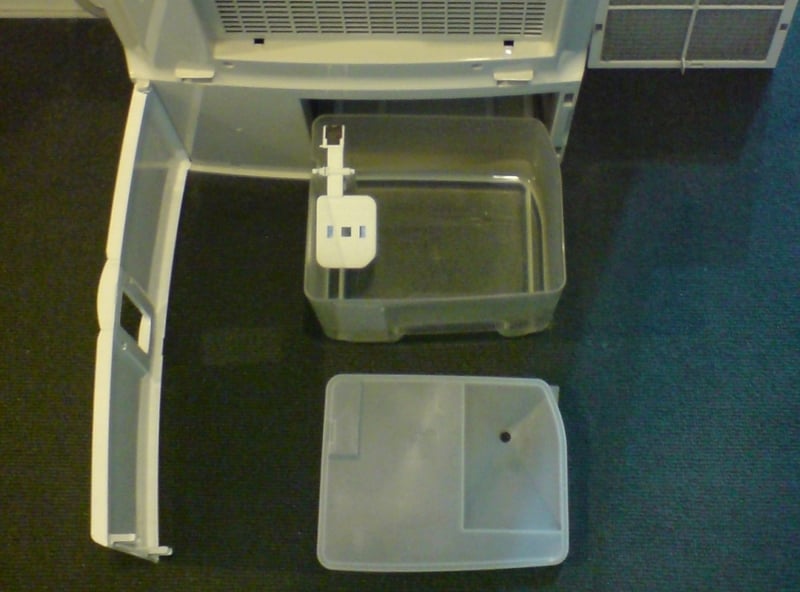
Dehumidifier Capacity vs Dehumidifier Bucket Capacity
Let’s say you have an option to buy from two 50 pints capacity dehumidifiers. One has a bucket capacity of 1 gallon (8 pints) and the other one has that of 2 gallons (16 pints).
Both of these dehumidifiers will collect water at the same rate i.e., 50 pints per 24 hours or about 2 pints per hour.
However, dehumidifier with 1 gallon capacity will need to emptied 6.25 times a day. While the one with 2 gallon bucket capacity will need to emptied 3.13 times a day, for a continuous 24 hour operation.
That is a lot of difference in emptying frequency. By doubling bucket capacity, number of times you have to empty your dehumidifier bucket reduces to half.
Thereby, before you buy a dehumidifier, despite operational capacity, also look for water holding capacity of the unit. This will save you a lot of time and trouble in future.
Solutions
If your dehumidifier has a very low bucket capacity and emptying bucket is a troublesome activity for you, don’t worry. I have 3 solutions for you:
- If you just got your dehumidifier, there is ample time to return it. Get one with higher condensate capacity.
- Get rid of draining problem entirely by automatic drainage via drain hose. Remember, as I told earlier, water needs to go in the direction of gravity for this to work i.e., in descending path.
- Best option is to use a condensate pump. No need to consider gravity with this, just connect the condensate pump and be worriless.
Useful Information: There are dehumidifiers available in the market for which you don’t even have to attach an external condensate pump. They have a built-in condensate pump. All you have to do is connect it with a pipe and extend the pipe to draining location.
8. Excessive Humidity in Dehumidifier Room
Relative humidity varies for different spots, rooms and zones of your home. Rooms that are exposed to high water content regularly will have more humidity in their environment.
For example, you can expect high humidity in bathrooms, kitchens and laundry rooms due to water used for bathing, cleaning dishes and washing clothes, respectively. This is the reason these areas are most susceptible to mold.
Similarly, many people face high humidity problems in their basements due to poor insulation, especially if there are cracked foundations or water pipe leakage.
Installing a dehumidifier is one of the mandatory actions when humidity problem gets this high to prevent your health, home and appliances.
One of the reasons for your dehumidifier accumulating water at a very high rate is the location where it is installed in your home.
Solutions
There are two scenarios when location in your home is the cause of water collecting very quickly:
- You shifted your dehumidifier from one room to another and now it has started collecting lots of water very rapidly.
- You are running dehumidifier in a very humid spot of your home since the time you bought it, like in a humid basement or attic.
In the first scenario, it is most likely that high humidity in the new spot of dehumidifier in your home is the problem.
However, in the second scenario, to diagnose the problem, I recommend you firstly check other convenient and likely reasons for water collecting very speedily, like dirty filter, clogged coils, damaged fan etc.
Pro Tip: To confirm, run it in a different room, like your bedroom, and check the rate at which it captures water. If it reduces to a large extent, this is an indication that relative humidity in the previous location of dehumidifier was relatively very high and that was the reason for bucket filling up very quickly.
After diagnosis, as I explained above, if you identify that humid location of your home is a problem, such as due to water leakage or poor ventilation, fix the problem causing very high humidity in that place. If you don’t, high moisture content can cause damage to you and your home. Then use one of the following strategies:
- Use drain port to get rid of condensate automatically (water needs to go in the direction of gravity).
- Use a dehumidifier with internal pump or attach external condensate pump with your dehumidifier. I have linked my selection for you previously in the article. In this method water is automatically drained, regardless of the relative height of drainage.
- If you cannot easily extend drain hose to drainage, like in basement, consider a dehumidifier with very large bucket capacity.
If you choose to buy a dehumidifier with large bucket capacity, give a look to Midea Cube dehumidifier. It has a tank capacity of 4.3 gallons due to its unique design. This is about 3 times in comparison to other dehumidifiers. In case you are wondering, it also has an internal condensate pump and comes with Wi-Fi control.
9. Malfunctioning Dehumidifier Components
Dehumidifier extracts water from your home environment that keeps collecting in the bucket. When bucket is full, your dehumidifier stops the operation to prevent overflowing of the bucket on the floor.
If your dehumidifier stops running after very short durations of time, it is possible that there is a problem with float switch.
Float switch is installed in the bucket and responsible for identifying true level in the bucket. If you have a faulty, incorrectly positioned or displaced float switch it will provide incorrect signal to dehumidifier.
As a result, dehumidifier will turn Off much quicker than it should depending on its bucket capacity.
Similarly, there can be a problem with the drainage via drain port or internal condensate pump. With these two ways of water removal, your dehumidifier should never fill up.
However, if it does fill up due to a problem, your dehumidifier will shift to primary method for draining water i.e., drainage via bucket. This could be a reason for bucket filling up despite use of automatic drainage.
Solutions
To check if float switch is malfunctioning and indicating full bucket when it’s not, check water level inside it, when bucket full light is ON.
If there is a good amount of capacity still available in the bucket, float switch is likely not working and needs replacement. However, if dehumidifier bucket is filled almost up to its full capacity, then there is some other problem.
As far as dehumidifier bucket filling up, despite use of automatic drainage is concerned, I personally would check external problems, like any blockage in the drain hose, before blaming the internal components of the dehumidifier.
Check drain hose for any blockage inside, look for any perpendicular bends and assure that the height of drainage is lower than your dehumidifier, in case you are using gravity method.



